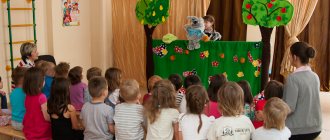Proper care
Caring for indoor plants in kindergarten includes several stages. Children can also be involved in them.
- Watering is done with water at room temperature, left to sit for 1-2 days. 30-60 minutes after the procedure, the water is poured out of the trays;
- Spraying - carried out with water at room temperature from a fine-grained spray bottle. Helps keep plants fresh and green;
- Washing - to remove dust and dirt, plants that do not have pubescent leaves are periodically washed under a warm shower. The soil in the pot is covered with oilcloth;
- Loosening the soil - done the next day after watering to a depth of 1-1.5 cm;
- Transplantation is carried out when the roots have entwined the entire pot, mainly in the spring. The new pot should be 3-4 cm larger in diameter than the previous one;
- Fertilizing – fertilizing with mineral fertilizers is carried out 2-3 times a month after watering;
- Reproduction - can be carried out in different ways: seeds, cuttings, bulbs, dividing the bush, layering;
- Pest control – the most common dangers are spider mites, scale insects, aphids, and mealybugs. Insects are removed mechanically, after which the plant is washed with soapy water.
Did you like the article? Share it with your friends on social networks:
Flowers for kindergarten
The child spends most of the day in kindergarten.
Therefore, it is natural that parents want it to be cozy and comfortable there, just like at home. Indoor plants can help with this. In addition to aesthetic pleasure, flowers in kindergarten also bring practical benefits . They perfectly clean the air of dust and toxic substances. The phytoncides that some green “pets” secrete have bactericidal properties.
Scientists have proven that in a room where there are indoor plants, the number of harmful microorganisms is halved. Plants increase the level of air humidity, which is especially important during the heating season.
In addition, representatives of indoor flora have a positive effect on the mental and emotional health of children, bring joy, and relieve fatigue. It’s also an opportunity to get acquainted with the world around us, learn how to care for plants, and develop responsibility and kindness.
However, despite all the advantages of having indoor flowers in a kindergarten, not every one of them is suitable for this institution.
Preview:
Summary of organized activities
"Taking care of indoor plants"
Objectives: To summarize children’s ideas about caring for indoor plants; consolidate children's knowledge about the basic needs of indoor plants, generalize knowledge about how to care for plants (watering, dust removal, loosening); introduce the rules of watering plants; develop speech, develop work skills, cultivate a love for plants, a desire to care for them.
Material: Indoor plants, basin, watering cans with water, rags, tassels, oilcloths, aprons.
V-l: Guys, listen to what poem Anya knows!
Anya reads a previously learned poem:
V-l: Let's once again admire our garden on the window and remember what kind of indoor plants grow in our place.
Vl: Let's play a game: now each of you will make a wish for a houseplant, tell us about it without naming it. And we will guess the plant and name it.
Q: What do plants need to live?
V-l: Yes, guys, water is very important for flowers. How to properly water indoor plants?
The child reads a previously learned poem:
V-l: Guys, imagine that the owners are going on vacation, and they have indoor plants at home. If they leave, there will be no one to water the flowers, and they may die. What to do? How to go on vacation and prevent your indoor plants from wilting?
Children solve a problem situation: Give flowers to neighbors; give the keys to the neighbors so that they can come and water; pour more water into the trays; put them in a bath of water; take with you; put one end of the rag into the bucket and the other into the pot; Draw the hose from the bucket as well; leave dad at home; buy a special robot, etc.
Vl: Let's remember what else do plants need to feel good? How to care for indoor plants?
Q: Why do you need to loosen the soil? What do you use to loosen the soil?
Children: The earth is loosened so that water is well absorbed, so that it is easier for the roots to breathe. You need to loosen it with sticks so as not to injure the roots, since some plants have roots close to the surface.
V-l: What else needs to be done?
Q: How to properly wash plants?
Children: Large leaves are wiped with a cloth, plants with small leaves are placed in a basin, we cover the soil with oilcloth so as not to wash it away, and water from a large watering can or spray bottle; dust is brushed off from leaves with a rough surface with a brush.
V-l: Our plants also need care. Shall we help them? Well! Then put on your aprons and get to work!
Source
The best plants
- Chlorophytum - is a rosette of leaves with “mustaches”, at the ends of which there are small “babies”. The plant is unpretentious, recovers quickly, and tolerates irregular watering. Perfectly purifies the air from bacteria, viruses and exhaust gases;
- Crassula, or Crassula, is a fast-growing tree-like plant with fleshy, glossy leaves. Broken cuttings can be used for propagation. Unpretentious. Helps improve performance;
- Fern - has a lush, beautiful appearance. Grows quickly and recovers easily. Undemanding in care, can grow in partial shade. Helps cope with stress and relieve fatigue, improves concentration;
- Citrus fruits are beautiful trees that can grow both in the shade and in the light. They contain many essential oils that have bactericidal properties and neutralize harmful microorganisms. Citrus fruits also cope well with fatigue, eliminate irritability, calm and improve sleep;
- Hamedorea graceful is an ornamental deciduous plant similar to a palm tree. Unpretentious, can grow in partial shade. Excellent air humidification. Purifies the air by eliminating hazardous substances released by plastics;
- Hibiscus, or Chinese rose, is a shrub that can grow in partial shade. The stems are elastic and resistant to damage. Hibiscus has well-defined stems, leaves and bright flowers, which will help children study the structure of plants;
- Tradescantia is an ampelous plant that can be hung in a flower pot. Undemanding to watering and lighting. Perfectly humidifies and purifies indoor air. It is distinguished by its ability to neutralize electromagnetic radiation;
- Kalanchoe - secretes phytoncides that neutralize fungi and bacteria. It has medicinal properties: anti-inflammatory, wound healing. Helps with cough, runny nose, flu, furunculosis;
- Schefflera is a beautiful decorative deciduous unpretentious plant. It perfectly purifies the air from harmful substances present in cigarette smoke, such as nicotine and various tars.





